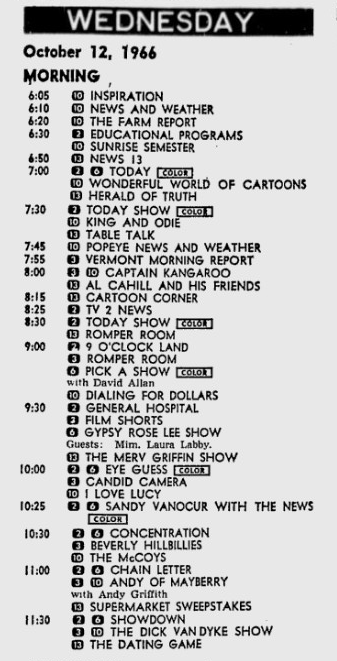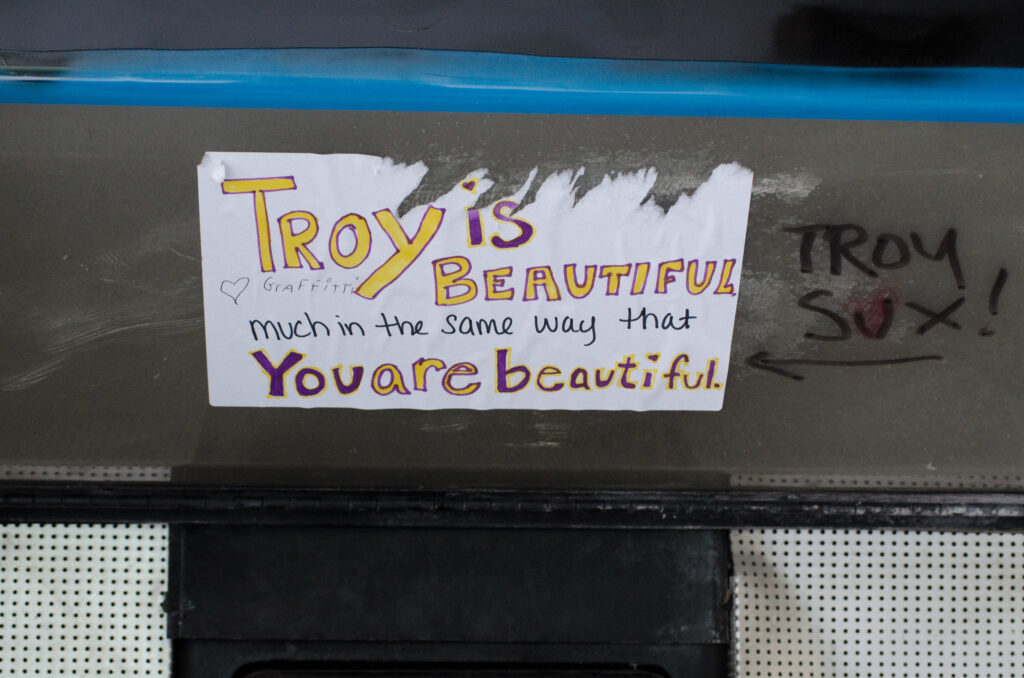Three channels and nothing’s on
 Our elders had the hardships of the Great Depression and the Second World War, and they weren’t shy about telling us how soft we had it. My generation had civil unrest (race riots, Vietnam protests, the Generation Gap), the Cold War, and only three television channels. And while it’s hard to scare kids going through today’s Depression with stories of Kent State and the Watts riots, I’m not shy about telling how hard life was with only three television channels. (Yes, you could say there were four, if you counted what was still called “educational televsion,” and if you could stand in just the right spot, holding onto the UHF antenna in just the perfect way to would bring in what looked like a signal, if you squinted just right.) Why, in my day . . .
Our elders had the hardships of the Great Depression and the Second World War, and they weren’t shy about telling us how soft we had it. My generation had civil unrest (race riots, Vietnam protests, the Generation Gap), the Cold War, and only three television channels. And while it’s hard to scare kids going through today’s Depression with stories of Kent State and the Watts riots, I’m not shy about telling how hard life was with only three television channels. (Yes, you could say there were four, if you counted what was still called “educational televsion,” and if you could stand in just the right spot, holding onto the UHF antenna in just the perfect way to would bring in what looked like a signal, if you squinted just right.) Why, in my day . . .
This schedule from October 12, 1966, shows the Albany-Schenectady-Troy area channels. Channel 6 was WRGB in Schenectady, the NBC affiliate since television and networks were invented. Channel 10 was WTEN in Albany, the CBS affiliate. Channel 13 was WAST (Albany Schenectady Troy) in Menands, the ABC affiliate and the channel with the worst signal when I was growing up. Except for Channel 17, WMHT, on the UHF band, which required special pliers to adjust the tuning knob and a contortionist to get the antenna into the right arrangement. (Channel 2 here is a Utica station; Channel 3 came from Burlington. Neither one could be picked up in our area but the Schenectady Gazette, source of this listing, was widely distributed.)
Television wasn’t on 24 hours a day (neither was a lot of radio). It signed off with “The Star Spangled Banner” somewhere after midnight, and came back on with a few minutes of test pattern sometime after 6 a.m. Then, depending on the channel, it would start with something religious, educational, farm-related, or all three. Most importantly to me (and probably to my mother), there were cartoons early in the morning. “King and Odie” is mostly forgotten, I think, but it did feature Tooter Turtle, the hapless character who cried out “Help me, Mr. Wizard!” in every episode. Now I understand the Popeye cartoons to be an abominable desecration of Elzie Segar’s brilliant comic strip, but when I was six I looked forward to every single burst-open can of spinach. (Can. Of. Spinach. Vegetables, in cans. This is how my childhood really differs from my children’s.)
Then there was something that doesn’t exist any more, despite all the “local” and “in your community” slogans: local programming. Shows made here. This schedule may have come just after the hugely popular “Freddie Freihofer” children’s show had ended. Sponsored by famed local bakery Freihofer’s (yes, we used to have local bakeries, and elementary school wouldn’t have been complete without a field trip to the bread bakery on Washington Avenue in Albany). But there were also local shows for grownups on the schedule — here we see both “Pick A Show with David Allan” and “Dialing for Dollars” with Ralph Vartigan and John Stewart. For the kids, it eventually became clear that Ralph Vartigan was really “Commander Ralph,” of The Good Ship News. (Click the links for local blogger Chuck Miller’s appreciations of those shows.)
The morning programming was dominated by talk shows, game shows and reruns of prime time shows. If you didn’t like Pick A Show or Dialing for Dollars, you were stuck with Romper Room. Or turning off the TV. These were our choices. As a sickly kid, I spent a lot of time lying on our couch, watching absolutely anything that was on, and yet I’m still surprised at how many of these details I’ve forgotten. I didn’t remember that Commander Ralph’s “co-host” was Mr. Monkey, or that there was a Bill Cullen game show called “Eye Guess” (and I even owned the home version). I worry sometimes that my mind is filled with pointless trivia that doesn’t leave room for important things (like birthdays and anniversaries), but apparently even the pointless trivia has some kind of shelf life.


I know it’s not the case, but I’m going to pretend “Popeye News and Weather” at 7:45 on WTEN was Popeye himself delivering the news straight and then giving us the weather report.
The fact that the TV listings once needed to indicate “COLOR” as something other than the default setting is another mind-blowing marvel to our kids, I would suspect . . .
I’ve explained to them a number of times that the world itself was in black and white until about 1967. They don’t seem to believe it.
Actually, I’m still stunned when I see repeats of TV shows from the ’60s and they’re in color. Batman, Star Trek, etc. — I didn’t have a color TV until the ’90s so it amazes me that these things were not only in color, but rather brilliant color at that.
Channel 3 in the Gazette could have been out of either Burlington (not Bennington), VT or Hartford, CT, both of which were and are CBS affiliates then and now.
It’s neat seeing the schedule from then. My family only had B&W tv until a few years after we left NY State late in 1976, so we never saw these shows, at home anyway, in anything but B&W.
My 2nd grade class visited WTEN studio near the end of our school year in June 1973, and I remember seeing the set for Commander Ralph’s Good Ship News, but I don’t think we met Ralph himself that day.
I’m checking with an expert on Channel 3. Since at the time we couldn’t reliably pull in Channel 13, it struck me as unlikely that anyone could be getting a signal from Burlington, but now I suspect you’re right.
I’ve been told it was WCAX in Burlington.